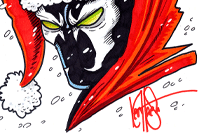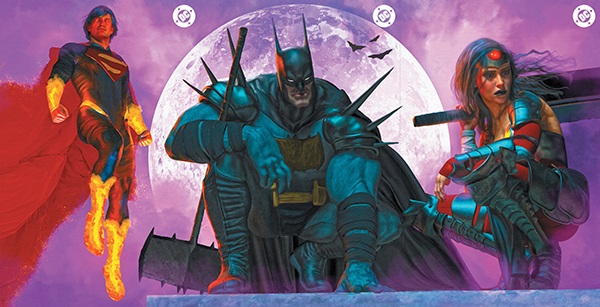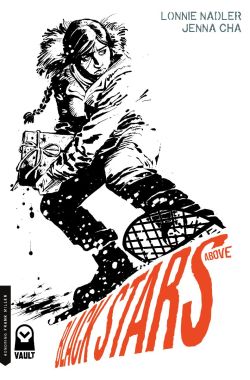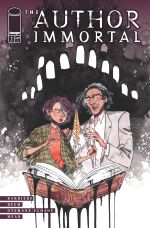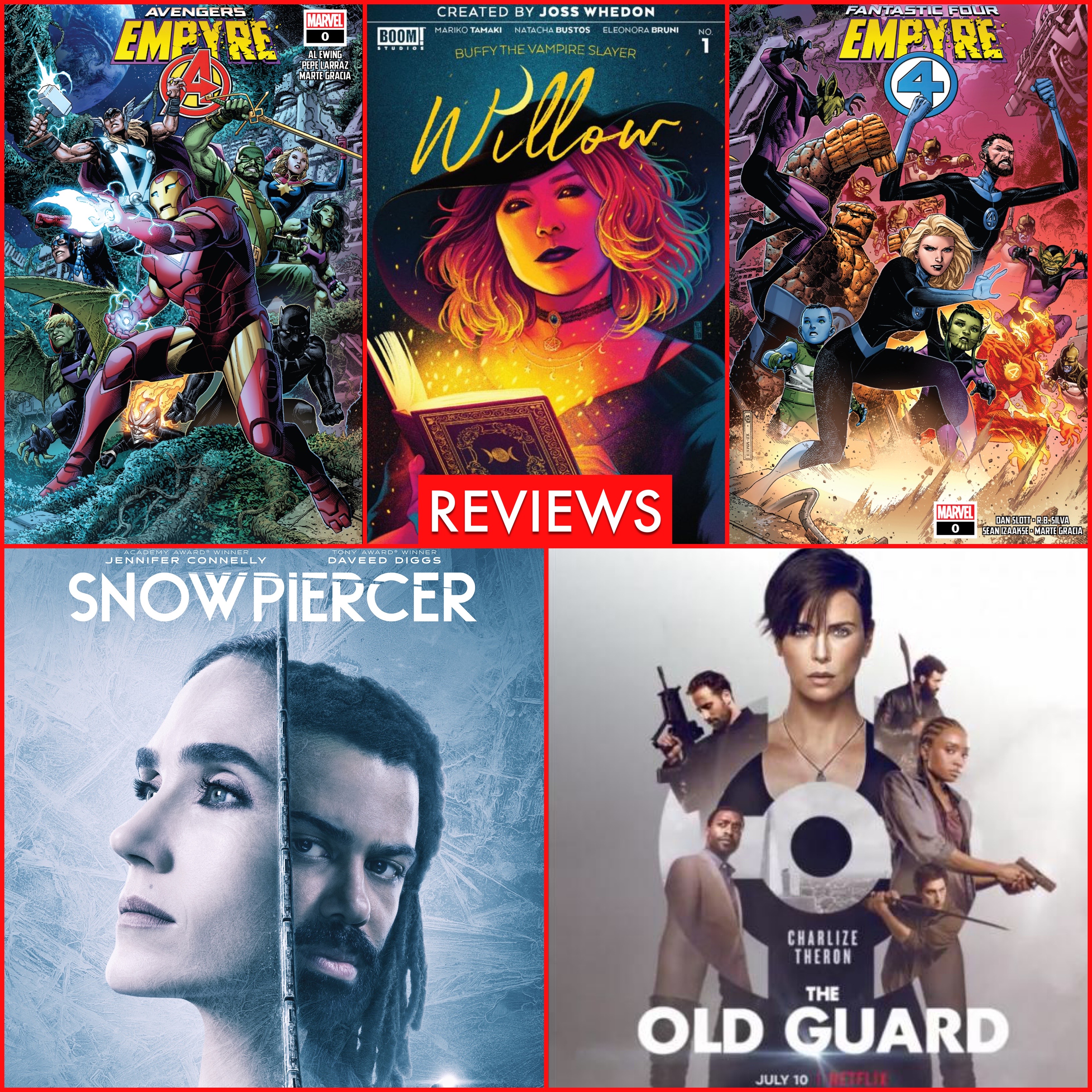|

|
LONNIE NADLER & JENNA CHA
 SEND THIS TO A FRIEND! SEND THIS TO A FRIEND!
DF Interview: Lonnie Nadler & Jenna Cha bring eldritch horror to the Canadian wilderness in ‘Black Stars Above’ By Byron Brewer The year is 1887 and a storm brews. A young fur trapper flees her overbearing family only to get lost in a dreamlike winter wilderness that harbors a cosmic threat. The fur trade is dead and the nation is changing. Yet, Eulalie Dubois has spent her entire life tending to her family’s trapline, isolated from the world. A chance at freedom comes in the form of a parcel that needs delivering to a nameless town north of the wilderness. Little does Eulalie know, something sinister hides in those woods and it yearns for what she has. A horror story that's part The Revenant and part At the Mountains of Madness, Black Stars Above is a chilling historical cosmic horror tale of survival from the deranged minds of writer Lonnie Nadler (The Dregs, Marvelous X-Men) and debut artist Jenna Cha, with colorist Brad Simpson (Coffin Bound, Fair Lady), and letterer Hassan Otsmane-Elhaou (Test, Peter Cannon: Thunderbolt). To get the full 411, DF sought out co-creators Nadler and Cha. Dynamic Forces: Lonnie and Jenna, each of you please tell me about the genesis of this saga for you and how you came to collaborate as co-creators. Lonnie Nadler: It started for me while I was reading Margaret Atwood’s book, Survival, which functions as an exploration of Canadian literature. I’ll spare you the boring details about the history of my country’s bibliography, but the book filled me with an unrelenting desire to tell a distinctly Canadian story about the nature of survival, in all its forms, that would also appeal to a broader audience. Canada has such a beautiful but horrific natural landscape, ripe pickings for visual storytellers like Jenna and myself. And, me being me, horror imagery immediately wormed its way into the impulse to play in this kind of setting. I couldn’t get this one image out of my mind – a young fur trapper in the 1800s in the snowy wilderness holding a parcel while a bizarre black star watches her from the sky. I love the horror genre but I’m also very wary of the tropes and cliches that can latch themselves onto it, so I knew that if I was going to do this kind of narrative properly I would have to find a way to make this cosmic threat a personal one. There had to be a sense of the intimate or else there’s no point. I let the story gestate and eventually it struck me that this seemed like a good avenue to explore the very human desire to escape lineage despite the fact that family follows wherever you go. There’s something inherently scary bred into the notion that some aspect of our lives is impossible to escape. It’s baked into who we are from birth. There are some things passed down to us, and we have no say in the matter. From there, story elements began to fall into place and before I knew it the pitch was done and Vault had greenlit this crazy project. The next step for me was finding the right artist. Given the very specific mood and style of Black Stars Above this wasn’t an easy task. I poured over artist portfolios for months and nobody quite had the “je ne sais quoi” I was so desperately seeking. That is, until I stumbled upon Jenna’s Twitter. Her hatchy, detailed style and love for horror injected her work a unique timeless quality. I immediately emailed my editor asking if we could get Jenna for the book. Funny enough, he was typing out an email at that very moment, about to ask me what I thought of Jenna’s work. It was perfectly serendipitous. And I thank the elder gods every day that Jenna was not only available but liked the pitch enough to come on board because it wouldn’t be the same without her. The same goes for our colorist Brad Simpson and our letterer Hassan Otsmane-Elhaou. They were my first choice for collaborators and they are truly helping to make this book something special. Jenna Cha: I had been in contact with Vault Comics after being taken on board to draw a backup for an upcoming Cult Classic issue. The great Eliot Rahal gave me my shot with that. I pretty much have him to thank as the catalyst for where I am right now. Like Lonnie said, the circumstances of including me in Black Stars Above was very serendipitous, especially because at the time I had been working on personal projects with the exact same moods and environmental visuals as this book. So, no way was I going to turn it down. When I first read the pitch, I was immediately hooked by how crisply the world of Black Stars Above manifested in my head. Its mode of storytelling had intention, investment, research, and most notably a voice. I grew increasingly more attached to the book the deeper we got into its development; Lonnie and I communicated very openly and extensively about its theming, mood, technical style, and the bank of visual references and inspiration we collected together. We left no stone unturned, but it hasn’t been difficult to remain eye-to-eye, given our grossly conjoined love for people like Junji Ito, Gustave Dore, Alfred Hitchcock, David Lynch, weird horror and old films in general. DF: Lonnie, as writer tell readers about the world you are creating here with Black Stars Above. Lonnie Nadler: The book takes place in 1887 in a mysterious part of Boreal forest somewhere near the border between Ontario and Manitoba. When the book begins, a malicious snow storm is brewing as winter is about to set in for good. And, as the title implies, there’s something otherworldly and nightmarish hiding in those woods. The result is an isolated setting that’s lush for drama and horror to sink their claws in. As you might be able to tell, an incredible amount of research went into this story. I’m talking reading numerous textbooks and historical documents on fur trading and the Métis people, visiting history museums, as well as speaking to people from these communities. I wanted every aspect of it to feel authentic from the clothing, to the home decor, to the food they’re eating, to the headlines on the newspapers, and even down to the types of trees in the forest. The hope is that we’re creating a unique reading experience that transports our audiences to a rich and fully realized place in history in an effort to ground the drama in authenticity before the supernatural elements begin to surface. I got a bit obsessive about the research because I have such an affinity for period piece storytelling and thankfully Jenna was game to deal with all my pedantic requests. In short, if you love movies like The Witch or TV shows like The Terror or comics like From Hell, this is made for you. DF: Introduce us to Eulalie Dubois. Lonnie Nadler: Eulalie is a sixteen year old Métis woman who’s been living and working in her father’s remote trapping cabin for her entire life. She knows very little about the outside world aside from what her parents tell her and what she reads in the old newspapers that her grandfather has collected over the years. But she has a relentless innate desire to discover that world, and ambitions to become one of those writers who brought her so much escapism over the course of her life. Because she lives this sheltered existence Eulalie is rather naive by today’s standards, but at the same time she’s so much wiser for it in other areas of life. The major example is that survival has been bred into her. It’s part of her DNA. Her backyard is literally the great Canadian wilderness and as a result she’s grown up as a skilled outdoorsman for whom things like hunting, building shelter, and scavenging for food are second nature. However, because Eulalie’s never left this isolated home life, when she encounters these monstrous threats, there’s a part of her that believes perhaps this is just the way the outside world works. The monstrous isn’t as monstrous to her. She doesn’t have as visceral a response as we would today and as a result she becomes an unreliable narrator, yet one who can fend off madness a little bit better than the average city dweller today. It’s probably also worth mentioning that Eulalie is at a time in her life that’s propelled by self-discovery. This is a coming of age story, albeit not your typical one. DF: Give readers the storyline for your series, without spoilers. And what can you tell us about your love of horror in general, and cosmic horror (is that “a thing”?) in particular? Lonnie Nadler: The crux of the story is built around the idea that the nation as a whole is changing because the fur trade has been dead for some time. Eulalie’s family is no longer able to continue surviving as secluded fur trappers, and as a result tensions are high and seismic shifts are about to take place within the Dubois family. Eulalie is offered a way out of all this when a strange man asks her to deliver a parcel to a nameless town north of the woods. What follows is a series of increasingly bizarre and horrific events that test the limits of Eulalie’s sanity and willingness to survive. Regarding horror, I could go on about the merits of the genre for days, but for the sake of brevity I will try to keep this concise. Horror, for me, has always been about intentionally exploring the darkest, most chaotic, most unknown aspects of both ourselves and the environments we inhabit, and in doing so, reaching a greater understanding of humanity and what it means to exist in this world. Or, if such is not possible, then to at least ask questions about our place and the nature of our being in order to feel a sense of catharsis and release in the idea that some things can never be known. Cosmic horror is strongly related to such notions because it explores the unknown, the undefinable, the sublime threats whose origins are otherworldly and the effect those have on humans when they realize we are so insignificant in the grand scale of things. Cosmic horror was largely invented by H.P. Lovecraft, most famously in his story The Call of Cthulhu, and while he’s the godfather of the subgenre, it has evolved greatly since his time. Black Stars Above is very much an effort to tell a story that fits in line with the work of Lovecraft and his contemporaries, bringing some bizarre and eldritch threats into a time period and setting that would have very specific reactions to that kind of thing, while also imbuing that type of narrative with more modern ideals. DF: Jenna, how challenging has Black Stars Above been as your very FIRST publication? (And how excited are you? LOL!) Jenna Cha: The experience of my very first long form publication has been this: some days I feel like Dennis Hopper with an oxygen mask while Lonnie hides in a closet, other days I feel like a lousier Henry David Thoreau in the middle of the woods with less transcendentalism and more cabin fever. I feel like Robin Williams during the weirdest parts in What Dreams May Come. Some days are a hundred years of solitude, other days are rolling on the river. Most days I feel like the bus in Speed. In all seriousness, Black Stars Above has been a dream project. Lonnie takes deep care in his grasp of the comic language, which is incredibly fulfilling for me as an artist. Since the book is crafted by visual storytelling with many moments of silence and action, I’m given free range in composing imagery with layers and nuance. This book has really pushed me to think more inventively with my compositions in order to convey concepts and reactions hidden in plain sight, and I’ve been allowed to push myself in thinking more cinematically both in sequence and aesthetics. For how challenging the book has been to draw, I’m grateful to be cutting my teeth in a project that strikes a lot of aspects of my skill sets. If this book doesn’t kill me, it’ll make me stranger. DF: What can you share about designing these characters and set pieces (which I assume) and can you let us know about any research you did for establishing the book’s very unique atmosphere? Jenna Cha: My style is a bit on the rougher side with lots of hatching, so conveying the dark mood of the book accordingly was a priority that I felt very comfortable with. Drawing the lush landscape of the Canadian wilderness peppered with flash bangs of creepy cosmic horror imagery made for a fun call-and-response experience of juggling such a marriage of things. My main reference books (which were already in tow) included works by Bernie Wrightson, Gustave Dore, some Stephen Bissette here and some Franklin Booth there. One of the biggest visual influences on Black Stars Above was the film The Witch, which I had already seen and loved, and I was also advised to get familiar with The Revenant. Lonnie’s diligent research into the historical accuracy of 19th century Canadian frontier life and First Nations gave me a steadfast foundation for illustrating the set pieces down to the very utensil. Furthermore, I’ve always loved photographers such as Ansel Adams and Edward S. Curtis—I took the opportunity to study their outlook on the natural world and regard the depiction of the wilderness with that kind of respect. In regards to designing Eulalie and the characters, I wanted to make sure their demeanors and resting expressions were realistic in their settings. Their lives were rough. Everyone’s got wrinkles, nobody’s smiling. I especially wanted to depict Eulalie as realistically as possible. Her intelligence, willfulness, courage, physical strength, as well as her stubbornness are founded on her inborn will to survive. The brutality of her environment in which she calls home crafted her into a being meant to adapt and persevere; such qualities of a person moreover protects her human need of freedom. What I respect the most about Eulalie is her strength in refusing to yield to the confining and destructive circumstances of her environment in and outside of home, and lose touch with her need for personal fulfillment as much as her will to survive. With all this in mind, her design had to carry a lot of implied weight, physically and thematically, as if she was always tired to some degree but never letting her head fall. Her stubbornness gives her a hard expression, and she is always alert. She’s levelheaded and very astute to the dangers around her, and thus, not above showing fear. DF: Talk about color artist Brad Simpson and how his contributions may have since influenced your work, and how you collaborate on the visual storytelling. Jenna Cha: Brad elevates our comic, like everything he works on, to a level I couldn’t imagine. He’s a master of the craft. Lonnie and I had a firm idea of how the colors should look for this world—dreary, subtle, a bit desaturated, atmospheric, sometimes painterly and overall on the softer side. Brad nailed it on all counts; he knew exactly what we were going for, but he breathed everything to life with his own voice. His palettes are very naturalistic and beautiful; warm and intimate with interiors, like how a rural 1800s cabin household would be, and relentlessly biting in the snowier scenes. Brad knows how to isolate characters in their environment and enhance the feeling of creeping danger in the middle of visceral survivalist situations. This has made me much more aware of the collaborative aspect; I draw the scenes with areas of nuance where I could see Brad having fun with it and throwing around his flare. Since the book is so deep in its nature settings, we can go on a jaunt in playing with strong, weird light and shadows, contrast and atmosphere. I absolutely hope to work with Brad again in the future whether he likes it or not. DF: Jenna and Lonnie, what other projects, inside or outside comics, can readers look forward to from you? Lonnie Nadler: While Jenna and I are focusing on Black Stars Above at the moment, pouring everything we’ve got into the pages, we’ve also begun working on a new project together. I can’t say much about it just yet because it’s in very early stages, like a pupa waiting to metamorphosize, but Jenna and I share the same brain and this next project is going to be even weirder and even more deranged. Other than that, I’m writing a Yondu series at Marvel, also set for release in November, I have a gothic graphic novel in the works, and I have a revenge Western slated for release in 2020. I’m a busy boy. Jenna Cha: I have plenty of stories I’m waiting to unleash onto the world, most of which are graphic novels I want to both write and draw. This new project of ours that Lonnie mentioned is something I pitched to him a few months ago. Since he’s Canadian, he’s too polite to say no, so here we are! While this project is still in its developing stages, all I can say is that it’s a grotesque marriage of suburban mid-century America and Junji Ito-esque body horror...pure sick. Dynamic Forces would like to thank Lonnie Nadler & Jenna Cha for taking time out of their busy schedules to answer our questions. Black Stars Above #1 from Vault Comics hits stores Nov. 6th!
NEW! 1. 09/23/2025 - FRANK BARBIERE2. 09/16/2025 - RODNEY BARNES 3. 09/10/2025 - ZACK KAPLAN 4. 08/26/2025 - JOE PRUETT 5. 08/20/2025 - CHRISTIAN WARD Show All |
 |

